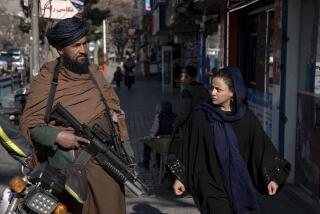Taliban flogging video may show different girl, but message is the same
- Share via
Reporting from Kala Kalay, Pakistan — With each stroke of the teenage Taliban militant’s lash, the girl’s muffled cries pierced the air of this Swat Valley town. The men in the crowd watched silently, aching to intervene but frozen by gunmen pacing in front of them with Kalashnikovs slung over their shoulders.
A year later, those men say the images from that day remain etched in their memories. The teenage militant wore white. The girl, a 17-year-old named Chand Bibi, stood behind a hastily made screen of sheets and shawls as she was flogged. She kept crying out, “Why? Why?”
But the rest of the world saw something quite different in a fuzzy, two-minute video shot by a lawyer that purported to show Chand Bibi’s flogging.
That video, made famous in the age of YouTube and cellphone downloads, stunned the country and gave the world a disturbing view of the plight of Pakistanis trapped in Taliban-controlled regions such as the Swat Valley.
Did the video show another flogging, or was it even staged? And if so, does it matter?
Activists say it doesn’t. The Taliban did flog Chand Bibi publicly, they point out, after the young woman and her fiance had been seen together in her house, which in the view of insurgents was a violation of Islamic law.
And whether her ordeal was the one shown on the notorious video or not, it awakened a nation that had underestimated the extent of the Taliban’s reach.
“It was the catalyst,” said Talat Farooq, executive editor of Criterion, a Pakistani current affairs magazine published in Islamabad. “When people spoke out about this, the tide turned and made it possible for the army to move into Swat.”
In great detail, the man who says he took the video, Swat Valley lawyer Shaukat Saleem, described what he saw and how he recorded the event. Chand Bibi was stretched out on the ground face down, with men holding her down by her feet and arms, he said.
A Taliban commander in a turban and gray tunic knelt down and flogged the girl 30 times. Saleem says he secretly filmed the event using a cellphone he hid in his coat. To make an opening for the lens, he cut a hole into the coat’s fabric.
“Whenever the lash came down, she would cry, ‘They are killing me! They are killing me!’ ” Saleem said in an interview in Islamabad, the Pakistani capital. “Tears were coming to my eyes. My whole body was in shock, but I steadied myself because I wanted to capture this video at any cost.”
Villagers in Kala Kalay say that, indeed, they saw Chand Bibi, as well as her fiance, flogged by the Taliban. But that is where the accounts diverge. Villagers say they have never heard of Saleem, and believe the video probably was of another flogging, either elsewhere in Pakistan or in Afghanistan.
“Obviously, that video isn’t of this flogging,” said Jaffar Khan, Kala Kalay’s mayor. “If [Saleem] claims it is, let him come here and say where it happened. He won’t be able to.”
Villagers say the couple were detained by the Taliban after someone reported seeing them alone together in her house, said the fiance’s cousin, who asked not to be named. They were held in separate houses for six days and questioned.
Then, on a cloudy March afternoon, Taliban militants marched the fiance, Adalat Khan, and Chand Bibi out onto a patch of dirt near a line of fruit stalls and grocery stores, villagers said.
“The Taliban militant who flogged the boy said, ‘The punishment we are giving to this girl and boy is not for adultery, because we don’t have evidence of that. But it’s a warning,’ “Khan’s cousin said
Khan, flogged first, was given 35 lashes. Then screening was put up to shield the crowd’s view of the girl. A teenaged Taliban insurgent walked up to her and struck her 17 times with the strap, villagers said.
“Everyone in the crowd was silent,” said Mohammed Ullah Khan, a 35-year-old CD store owner whose shop had been blown up by insurgents. “There was this feeling among us that we were witnessing brutality, but no one could do anything. It was power and force on one side, and total helplessness on the other.”
Chand Bibi and her family fled the village after the flogging. When Saleem was telephoned and asked to explain the discrepancies between his version of what happened and the Kala Kalay villagers’ accounts, he hung up.
Even if Saleem’s video was staged or depicted a different flogging, it had the effect of transforming Pakistan’s collective mind-set at a crucial time.
Before the video, much of the country had been indifferent to the Taliban’s conquest of Swat, a picturesque valley flanked by forested mountainsides, a favorite tourist getaway for Pakistanis. The Taliban gradually took over the region and imposed a strict code that barred girls from attending school, banned barbers from shaving customers and shut down all CD and music shops. Beheadings of opponents were common, as was the display of executed corpses in the main plazas of cities and towns.
In Kala Kalay, the Taliban was both reviled and feared. “They issued an order that everyone walking down the street had to keep their head lowered,” said Khan, the mayor. If a militant had his eye on a young Swati woman, Khan said, “he’d simply approach family and say, ‘I’m taking this girl.’ ”
Once the video appeared on the Internet and on newscasts, Pakistanis took to the streets to call for military action in Swat.
“You had women policymakers cajoling the menfolk that something needed to be done,” said Asma Jahangir, chairwoman of the Human Rights Commission of Pakistan. “People were less willing to sit back and do nothing.”
The Pakistani military mounted an all-out offensive against militants that routed the insurgency from the valley within nine weeks. Pockets of militants remain holed up in remote hillsides and woods, but refugees have returned, schools have reopened and for the most part everyday life in Swat has resumed.
The flogging video wasn’t the only catalyst for the restoration of normality in Swat, but it played a crucial role, Farooq said. While there may be doubts about its veracity, the message pushed the right buttons.
“I don’t think that the purpose was to deceive people,” Farooq said. “The purpose was to show what was happening. OK, maybe it wasn’t Chand Bibi. But it happened to a woman, and in a very undignified way.”
More to Read
Sign up for Essential California
The most important California stories and recommendations in your inbox every morning.
You may occasionally receive promotional content from the Los Angeles Times.










